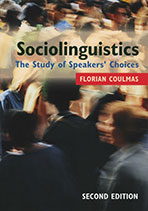Sociolinguistics
The Study of Speakers' Choices. Second Edition

Why do we speak the way we do? What are the social factors that influence our choices of expression? This best-selling introduction to the study of language and society encourages students to think about these fundamental questions, asking how and why we select from the vast range of different words, accents, varieties and languages available to us.
In this new and updated edition, students are taken step-by-step through the analysis of linguistic expressions, speech varieties and languages in complex settings. Enriched with recent findings from different languages and speech communities around the world, this comprehensive textbook equips students with knowledge of the main concepts and gives them a coherent view of the complex interaction of language and society.
- ‘Questions for discussion’ help students understand how speakers’ choices are conditioned by the society in which they live.
- New to this edition are lists of further reading and a repertoire of online resources, including 100 flash cards, enabling students to investigate more deeply and advance their learning.
- Includes a topical new chapter on research ethics, guiding students on the ethical questions involved in sociolinguistic research.
‘This is the book I’d choose to introduce students to the fast-developing field of sociolinguistics, for it combines clear explanations with intriguing examples.’
Bernard Spolsky, Professor Emeritus, Bar-llan University
‘A highly original synthesis of decades of sociolinguistics research, and an agenda setter, around the key notion of “choice”, for many years to come.’
Li Wei, Birkbeck College, University of London
‘To write a great introductory text you have to make a statement about fundamental issues. Here, the notion of choice bridges the gap between micro- and macrosociolinguistics and brings both cohesion and edge to the book.’
Frans Gregersen, The LANCHART Centre, University of Copenhagen
Contents
- List of figuresvii
- List of tablesix
- Preface to the second editionxi
- Introduction: notions of language1
- Part I Micro-choices 17
- Standard and dialect: social stratification as a factor of linguistic choice19
- Gendered speech: sex as a factor of linguistic choice42
- Communicating across generations: age as a factor of linguistic choice61
- Choice and change79
- Politeness: cultural dimensions of linguistic choice99
- Part II Macro-choices 119
- Code-switching: linguistic choices across language boundaries121
- Diglossia and bilingualism: functional restrictions on language choice141
- Language spread, shift and maintenance: how groups choose their language163
- Language and identity: individual, social, national189
- Language planning: communication demands, public choice, utility203
- Select letters: a major divide225
- The language of choice244
- Research ethics261
- Glossary of terms273
- References276
- Index299